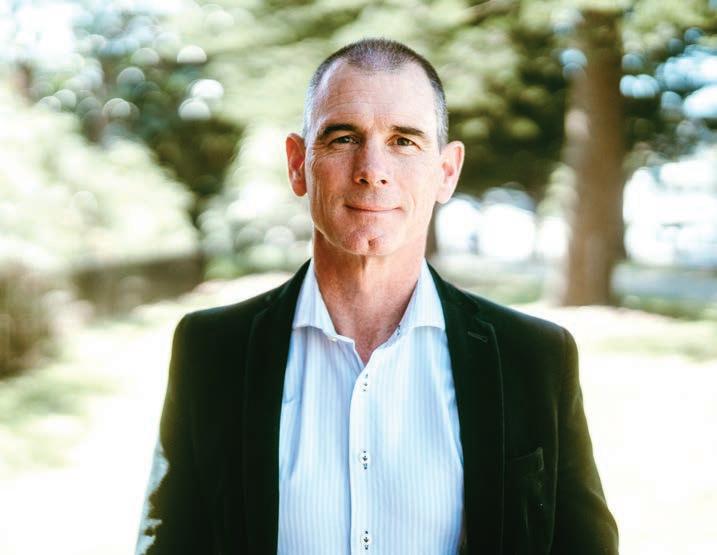
6 minute read
Global experience with local delivery
from MHD October 2021
by Prime Group
End-to-end supply chain consultancy enVista prides itself on its empirical, outcomes-focused approach to solving supply chain problems. Peter Kendall, Managing Director APAC, tells MHD why accountability is crucial to the company’s success – and how enVista’s recent expansion into the APAC region will benefit local companies.
According to Peter Kendall – Managing Director APAC at the international supply chain consultancy and software firm enVista – the group has always maintained steadfast focus on delivering results. With the vast majority of the enVista team comprised of people with strong industry experience, enVista does not engage in boosterish sales talk.
“For us, it’s all about actionable outcomes,” Peter says. “We’re not big on fancy PowerPoint presentations and big glossy reports. At least 85 per cent of the actions that we recommend on client projects will be actioned within six months of that project finishing.”
He says that enVista’s fundamental business model is to grow the company by delivering value, proving that value to clients, and earning the right to do more for them.
“Give us a problem, and we’ll help you with it,” is how Peter summarises the enVista approach. “If we do a good job on that, it earns us the opportunity to do more to help our customers. We’ve got a more-than 97 per cent client retention rate, which I think speaks to the efficacy of our mode of operation.”
TOTAL ACCOUNTABILITY, FROM END TO END
enVista was formed in 2002 and is headquartered in Indianapolis in the United States. Its core focus has always been supply chain consulting and working with clients on technological solutions. “Our customers are retailers, manufacturers, distributors, and 3PLs,” Peter says. “Over nearly two decades we’ve built a depth and breadth of experience across a broad range of industries. Since the bulk of our people come from industry, they’ve actually worked in the areas they now advise on. They have learnt the lessons of those industries – both good and bad. And this strong institutional knowledge is indispensable for guiding practical, actionable outcomes.”
Because of the depth of consulting talent at enVista, Peter says the firm rarely outsources responsibilities when it takes on a project. “We have the capabilities end-to-end to take a project from start to finish,” he says. “The acronym for our model is ‘CIO’ – ‘consult, implement, operate’. We take total accountability for the project. The buck stops with us. We’ll identify the problem, solve the problem, and then implement the solution – often a technology or process solution. We won’t recommend a solution we ourselves can’t implement.”
FIERCELY INDEPENDENT
enVista develops some of its own software in-house – in such areas as ‘Unified Commerce’, order management systems, and transport optimisation. But while the company seldom passes responsibility for any part of a project to third-parties, Peter says this doesn’t mean enVista is averse to implementing the best technologies on offer in the market to achieve project objectives.
“We’re independent,” Peter says. “We know all of the key technologies across WMS, TMS, LMS, ERP, and e-commerce systems. The value for those working with us is access to our deep experience and expertise,
Peter Kendall, Managing Director APAC at enVista.
developed over decades of working with different technologies and fostering relationships with key vendors. We understand the solutions on offer as well as the vendors do, in most cases.”
He says that, when working with a client, enVista will tell them what solution or technology it thinks is best, but will also run through a selection of competing alternatives as well. That way the client fully understands the broader context of what’s on offer and how enVista came to form its recommendation in an independent, impartial manner. “We know that we must always be prepared to run a system for our clients in the initial phase of implementation – so we’re not going to recommend something unless we’re confident it’s the best fit. Otherwise, we’d look foolish trying to run a system that wasn’t chosen based on an objective assessment. We wouldn’t be able to deliver actionable outcomes and quantifiable results. It just wouldn’t be in our best interest – let alone the client’s – for us to do that.”
NETWORK STRATEGY AND OPTIMISATION
Everyone is, by now, familiar with the large macro-changes that have affected supply chains, domestically and globally, Peter says (e-commerce, the repercussions of the pandemic, international trade disputes, and so forth).
He notes that when it comes to devising a supply chain network strategy for clients, instead of working off the traditional linear model of goods moving from, say, China to Australia on a ‘just in time’ basis, it is now imperative to strategise for a more resilient model – one less susceptible to the disruption that comes with putting all your eggs in one distributional basket. But how to achieve this? An essential key, he says, is to conceptualise the supply chain process in reverse – beginning with the question, ‘What is the customer demanding?’ and then moving backwards and outwards to determine the conditions and processes that must be in place to ensure those demands will always be met.
“After a proper assessment of the customer demand profile, we’ll then reverse the traditional supply chain sequence from a strategic perspective – considering the gameplan in terms of consumer-to-business, instead of starting with business-to-consumer,” Peter says. “We will then ask questions that follow on from that customer profile: ‘Based on your customer demand, where do you need different facilities in your supply chain? Where’s the best place to put them to service target markets? What capabilities and capacities will be needed at those facilities?’”
He adds that the Australian context is unique, owing to its geography, sheer land mass, and a relatively small population that clusters primarily on the coastal perimeter.
In this connection he cites work enVista did with a telecommunications company that was blanket-buying the inventory necessary for its infrastructure, without taking stock of what precisely was needed and in what quantities. The upshot, Peter says, was that the company was wasting money building up a backlog of “exposed and obsolete inventory”.
The solution, he says, was again to work backwards from the specific – conceptualising the supply chain and procurement system by formulating demand profiles of the SKUs [stock keeping units] involved, and then determining how – and how often – each SKU needed to be used. The next step was to zoom-out to determine the best method for ordering each type of SKU as well as the suppliers best positioned to accommodate the company’s inventory needs.

By delivering tangible results enVista has achieved a more-than 97 per cent client retention rate.
ENVISTA’S APAC EXPANSION
While enVista has long done projects in Australia and the Asia Pacific, in late 2019 it was decided that the company needed to establish a local presence with local personnel and expertise.
“We have amazing breadth and depth of global experience, but we wanted to combine that with local knowledge and execution in the APAC region,” Peter says. “It’s a culturally diverse region, and we wanted to provide our APAC customers with a service attuned to local issues and objectives. We need to speak the local language, establish on-theground credibility, and frame our objectives in ways that resonate with local experience.”
After the 2019 decision to expand, enVista first established permanent offices in Singapore and Sydney, and is continually expanding its presence, with offices in Bangkok, Auckland, Melbourne, and Perth. enVista’s vision for the region is a simple one, Peter says. “In a phrase, what we’re bringing to the table is this: ‘Global experience combined with local knowledge and execution’. Delivering on that simple idea is what enVista is all about.” ■










